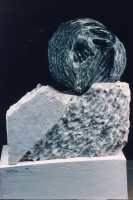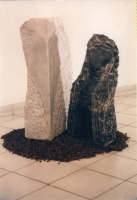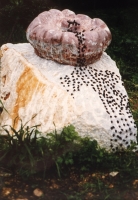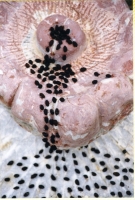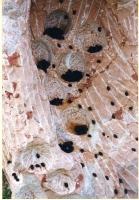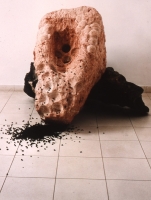In the exhibition “Hebron as a Paradigm”, Avi Sperber, artist, creator, and Israeli citizen, foresees in the current situation here, a year before the end of the millennium, a sad judgmental document about the political and social situation in which we find ourselves. According to him, the city of Hebron represents “Israeli heroism, where Abraham our forefather lived in coexistence with the Hittites and where King David began his reign over the people of Israel – and is today a symbol of contrasts and conflicts accompanied by a loss of values, reflecting life in a post-modern age where everything is allowed…”.
A series of dramatic sculptures create a hidden texture of harsh images and symbols. The sculptures according to Sperber have different meanings that create positive and negative associations that are expressions of the national situation in “a line that continues from vision to disappointment in a heavy atmosphere of past and future”. The choice of stone as a sculptural media, which encompasses the situation and provides testimony for years to come, creates a sort of massive memorial of frustration that awakens amazement and praise in the heart of the viewer. The symbols that Sperber chooses in order to demonstrate his feelings are lucid and clear to everyone. There is a feeling that the display of symbolic and “clear” stone sculptures increases the significance of the situation even more. This is a type of new archaeological creation, a signal of things to come. The use of local materials, Hebron stone, Turkish marble, olive pits – provide the series with a local touch which increases the feelings of oppression even more.
In this series Avi Sperber presents a prophetic exhibition, the first in a succession that over the years will become more steeped in social comment. His combination of massive stone with olive pits creates an original artistic texture, new and fascinating, that combines signs that belong and are interlaced between the inanimate and the live, between the existing and the hidden. His symbolic images are most interesting and often shatter existing myths. The sculpture of the dove (“You Promised a Dove”) is a good example of this – the drooped wing and the bird on its stomach give rise to feelings of compassion and sorrow; the sculpture “Co-existence” portrays sculptures in black and white placed on a pile of olive pits – a symbol shared by us and our neighbors. Another sculpture “Memory of a Trumpet Call” presents and quotes traditional symbols used for new practicalities far from their original intended goal, or “The Settlement Sculpture” that sarcastically portrays a large grooved stone which is transported from its natural place to a new, artificial one. The sculpture of the whitened angel provides a double meaning as a reminder and warning. On the one hand it is a character that alludes to far away worlds that watch over the present of humanity from above. On the other hand this is a white character, pure and clean, a symbol of tolerance and understanding between people. Either way, Avi Sperber’s exhibition provides, aside from the aesthetic experience connected with the beauty of the sculptures themselves, a few profound reflections on Israel, its natural resources and social events – things that affect our mutual future.
Zvika Israel, Curator
